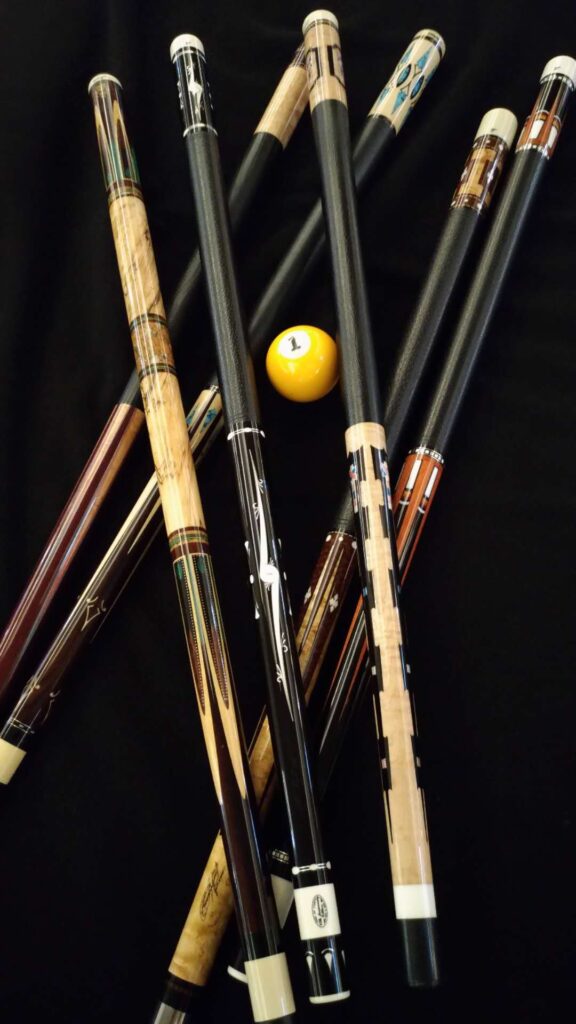It’s not just hard.
The play tends to be bland when the hint is applied.
In this article, I would like to talk about the “selection of equipment” in billiards.
If we assume that the “bat” and “shaft” of the cue have three hardnesses, “hard”, “medium” and “soft” respectively, we can think of a total of nine different combinations.
There are two types of “hard bat + medium shaft” where the deflection of the wood does not occur in the hand, and “soft bat + hard shaft” where the hand deflects.
Apart from the first time you choose your own cue, I think the real way to choose a cue is not only to look at the design of the bat, but also to look for the one that suits you among these combinations.
In carom billiards, squishy and soft things are rarely used, whether it’s the bat or the shaft.
Compared to pocket billiards, carom billiards is a much heavier ball and requires a lot of hard shots.
Therefore, the cue needs to be hard and solid in terms of structure and material, and a combination of “hard bat and hard shaft” is often chosen.
However, if it is simply stiff, the play tends to be bland when the hinges are applied. Many carom billiards players wrap rubber around their grips to compensate for the blandness of their play.
It’s called a “snake bible.”
There was also a shaft that vibrated in two places, like a snake.
Pocket billiard cues, on the other hand, used to be soft.
It’s like catching a ball with the deflection of a cue and pushing it out with a pounce, like a pole vault.
There was also a shaft called the “Snake Vibrate” that vibrated in two places like a snake.
Back then, “rotation” was the mainstay of the game, which used 15 balls, so the racks were bigger than the nine balls.
What’s more, in the old days, we didn’t have break cues, we used play cues to make break shots.
So, in order to split the racks efficiently, it was also necessary to take advantage of the flexing of the cue.
In addition, Pocket Billiards has a smaller ball and a larger diameter cue tip than Carroll Billiards, so it didn’t have to be as rigid as the original Carroll Billiards cue.
These days, however, games other than nine-ball and ten-ball are rarely played anymore, and break cues are available.
As a result, softness as such performance is no longer required.
Unlike carom billiards, the nine-ball can be played with a crescendo point close to the center, a vertical change and a few crescents.
In fact, if you watch a Nine Ball game for an hour, you don’t see many hard shots.
In the Philippines and Taiwan, you may see a lot of shots with a lot of screeching and a lot of hinging, but most of the time, most of the players do not put a lot of strain on the cue.
That’s why most pocket billiard cues today are made with a combination of a medium-sized bat and a harder shaft, and many people may think that such cues are more reliable. In other words, the cue is designed to hit the cue accurately with a narrow cue.
A golf bunker shot is
No matter how hard you try, you’re not going to jump 200 yards.
Now that you know which bat and shaft combination is right for you, the next step is to talk about what hardness of tip to use.
I think “M” can be used for most of the medium cues that are not too hard or too soft.
But I don’t really recommend putting a soft tip on a hard cue for the purpose of neutralizing the hardness.
Of course, having a soft tip on a cue that is hard enough to “squeak” when it’s shot would be a relief.
However, as a tip maker, I recommend tips with a firmness of about M, which gives a firm feel even with a hard cue.
I think a harder tip, especially if you don’t have a lot of power, will help you get some nimble shots.
What I can’t recommend over the combination of “hard cue + soft tip” is the choice of “soft cue + soft tip”.
With this combination, it is easy to lose power and the shot will be blurred.
A golf bunker shot won’t jump 200 yards, no matter how hard you try, because you’re chewing sand.
In the same way, with a soft tip, it’s easy to lose power the moment you hit it.
On the other hand, a solid tip like the M or Q is harder but more resilient.
So it doesn’t diminish the power that comes in, and it doesn’t take too much of it.
Even in baseball, if you hit a hard ball and a soft ball with the same bat, the hard ball will jump more.
It’s the same thing.
I think it would be a waste to kill the power with a tip.
Using the firm part of the skin.
Making a soft tip can be difficult.
The number of users of S and Q varies from region to region, but in general, Q has more users than M. In fact, globally, M is naturally the most used.
However, that doesn’t mean that I can’t recommend the S.
I recommend the S to swing like a swing without holding the cue.
In such strokes, it is difficult to catch the ball well, and it is easy for the ball to leap out without sufficient adhesion to the tip.
So I think it’s a good idea to use a soft tip like the S to make it easier to catch the ball.
Incidentally, there was no such thing as a “type of hardness” as S or Q before we made our tips.
For that matter, no manufacturer had been able to produce a soft tip like the S over a long period of time.
Even in the old days, the first thing that was required of tips was “unbreakable” before things like a good feel when you shot them.
To do this, you have to use a firm part of the skin, not a fluffy part.
But making a soft tip while using a firm piece of skin can be a challenge.
It can be made without pressing, but even then it is only soft at first, and as you use it, it gets harder and harder and puffs up.
In other words, it can’t stay soft for a long time, so the quality is not stable and needs to be replaced frequently.
From this perspective, soft and stable tips are difficult to make only in a laminated structure.
Musashi Miyamoto at Ganryujima.
I would have fought Sasaki Kojiro with the sword I liked best.
Choosing a tool is “choosing a weapon”.
This type of cue will give me an advantage in the shot,” or “The previous cue had this kind of weight and tip, so I’ll try this kind of cue next time”.
And to put it loosely, for the same amount of practice, I think the person who chooses a tool with the idea that “a tool is a weapon” will win.
Miyamoto Musashi may have wanted to fight Sasaki Kojiro at Ganryu Island with his favorite sword if he really wanted to.
However, I think that he chose the oar because he felt that he needed a tool that Kojiro’s sword could not reach in order to win.
I think it’s amazing that he was able to fight without any pretense, and I think that’s also true in the selection of billiard equipment.
I think you’ll feel better with your favorite cue for the design and how it feels when you shoot it.
But as far as playing fulfillingly, that’s another story.
At the end of the day, everyone wants to improve their averages more than they feel comfortable playing, and they want to get better.
Of course, it’s important that you don’t rely too much on your tools, but you should also work on overcoming shots that you’re not good at, but I think it’s a good idea to find and choose tools that will be a weapon for you.




